Most people who drink alcohol experience a hangover at least once during the course of their drinking. A hangover is a series of biological changes in the body. Symptoms can include headache, nausea, diarrhea, excessive fatigue and extreme thirst and dehydration.
The anatomy of a hangover: What causes a hangover?
Hangovers are not entirely understood. The symptoms are due to a combination of dehydration, electrolyte and hormonal imbalances, low blood sugar, and direct toxic effects.
The anatomy of a hangover: Dehydration and electrolyte/hormonal imbalance
Dehydration is caused by alcohol’s effect in the brain. It decreases a hormone called vasopressin. This is known as the anti-diuretic hormone (ADH) because when it is released in the blood stream, it prevents your body from excreting water in your urine. When it is suppressed from drinking alcohol, your body loses more water in urine. The effect is so strong that for every pint of beer you drink, you can lose up to four pints of water. This causes dry mouth and headache.
With all that water, you also lose electrolytes. When water is lost in the urine, sodium, potassium, and magnesium go with it. Loss of these vital electrolytes can cause feelings of nausea and fatigue.
The anatomy of a hangover: Toxins
The direct toxic effects have to do with the way alcohol is processed in the liver. Alcohol is broken down in the liver first to acetaldehyde, then to harmless acetic acid. Your body requires another chemical, glutathione, to break down acetaldehyde into acetic acid and clear it from your body. The problem is that when you drink a LOT of alcohol, you run out of glutathione and are stuck with the toxic acetaldehyde in your system while your liver makes more glutathione Acetaldehyde is the main chemical that is responsible for the symptoms of a hangover. It is more toxic to the body than the alcohol itself.
Toxins can also come from the alcohol itself. Congeners are alcohol derivatives that form as a byproduct of the fermentation process that is used to make alcohol. Congeners of alcohol are toxic to the body. They are found in higher concentrations in darker alcohols such as red wine, whiskey, bourbon and brandy.
The anatomy of a hangover: Who gets hangovers?
Every person reacts differently to alcohol. Some people can have one glass of wine and feel terrible in the morning. Other people can drink all night without feeling the effects. Age, genetics, medications, diet, immune systems, weight and gender all can come into play when it comes to a hangover.
The anatomy of a hangover: How to avoid it
The only foolproof way to avoid a hangover is to not drink alcohol. However, if you’re going to drink, slow down the pace at which your drinking, so your body has time to process it. Also, drink a glass of water for every alcoholic beverage that you have. Drinking on a full stomach is another good way to stave off a hangover.
Source: http://abcnews.go.com/Health/anatomy-hangover/story?id=12509637&page=2


